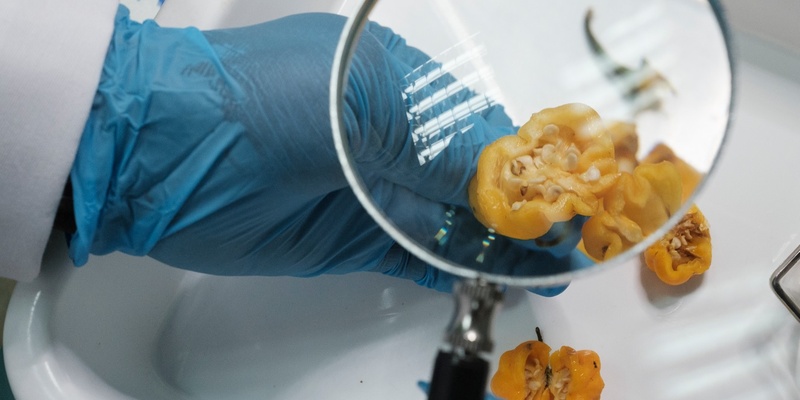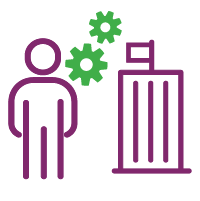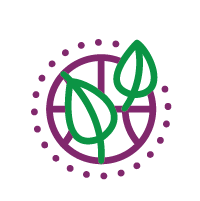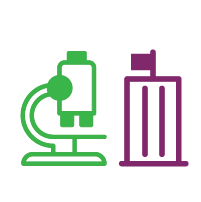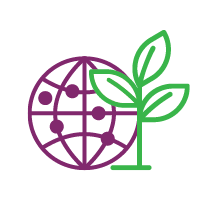Qu'est-ce qu'une évaluation des capacités phytosanitaires (ECP)?
The PCE is a collaborative process that helps countries evaluate their phytosanitary capabilities. National stakeholders, including the national plant protection organization (NPPO) staff, reach a consensus on the main phytosanitary gaps at the system, organizational, and technical levels. Under a structured framework, the PCE process helps identify how to address these critical gaps based on strategic planning and logical framework methodologies.
The PCE:
- Is a self-evaluation process driven by the NPPOs, giving them flexibility and control. Usually, it involves internationally trained facilitators who serve as navigators and guide the NPPOs in conducting a thorough assessment. However, the country may decide to conduct the assessment independently;
- Is supported by an online system comprising 13 modules designed in a questionnaire-style format to document the evaluation process systematically. NPPOs can select modules based on their current priorities and needs;
- Once the gaps are identified, the NPPO can create a sovereign plan to address and rectify these issues by applying strategic planning tools such as cause and effects analysis, SWOT analysis, logical framework, and the final output, a phytosanitary capacity development strategy which is validated by stakeholders.
To find out more about the PCE process and how to start one in your country, read the next steps below or contact Sarah Brunel, IPPC Implementation Facilitation Lead, at
[email protected]
PCEs in practice: examples and case studies
 Quels sont les avantages d'une ECP?
Quels sont les avantages d'une ECP?
 Qui dirige le processus d'ECP?
Qui dirige le processus d'ECP?
The process is driven by staff of the NPPO but should involve non-NPPO representatives from appropriate government agencies, research institutes, universities, agro-industries or import/export associations, etc.
The presence of an IPPC-certified PCE Facilitator streamlines the process while ensuring coordination and neutrality. Furthermore, the Facilitator's participation in the workshops enables participants to get a clearer understanding of the questions, Result-Based Management tools and suggestions on the next steps to take. Finally, the Facilitator supports the NPPO staff and private stakeholders in navigating through the PCE platform and briefs the participants in a teaching/training methodology prior to starting the process.
"PCE Facilitators guide discussions towards productive conclusions while refraining from expressing personal opinions, ensuring NPPOs and stakeholders take full ownership of the process. Facilitators also contribute to preserving the quality and integrity of the evaluation methodology by explaining and teaching the methodology and overseeing procedural aspects of workshops. It's important to note that facilitators enhance the objectivity of the evaluation practice".
 What does the PCE consist of?
What does the PCE consist of?
The goal of the process is to reach a consensus and develop a structured plan involving the country's stakeholders that addresses weaknesses and enhances the country's capacity in plant health. The PCE process will end in a National Phytosanitary Capacity Development Strategy and new or revised legislation/regulation.
To develop a National Phytosanitary Capacity Development Strategy, the process involves three PCE missions and various stakeholders who work together to identify gaps using a structured questionnaire format during the first mission. During the second PCE mission, strategic planning tools are used to develop a tailored plan for each module. The third mission involves validating the PCE findings, including activities and estimated costs, and following up on the implementation of the strategy and resource mobilization.
When the country selects to work on a new or revised legislation/regulation (Module 2), the process begins with a thorough Situation Analysis to assess the current legal framework's strengths and weaknesses during a first legal mission. As decided by the NPPO, drafting and consultation follow, involving stakeholders' input and the creation of a draft of new or revised legislation/regulation that addresses identified gaps. This draft is then reviewed and validated, ensuring legal soundness and international alignment. Finally, the Follow-up phase focuses on adopting and implementing the new or revised legislation/regulation.
 How is the PCE process applied
How is the PCE process applied
The PCE tool is available to any country upon making an official request to the IPPC Secretariat. Once contact has been made, a facilitator has been chosen and a PCE team is in place:
1. First PCE mission: situation analysis
The first PCE mission is held in the country and lasts about one week. It identifies and invites available members of the PCE team and relevant stakeholders. The mission starts with a briefing with the PCE team, followed by an official opening which may be attended by ministers.
A consensus workshop is then held with all relevant stakeholders to fill in the selected PCE Modules online. For each module, a maximum of five weaknesses are identified. The first PCE mission might also include technical visits to the airports, ports, border points, diagnostic laboratories, production sites, etc. A brief about the mission is prepared and sent to the FAO permanent representative, the highest authorities in the country and any stakeholders the PCE team considers relevant. A report is prepared after each mission and submitted to the IPPC Secretariat, indicating results to date and next steps.
2. Second PCE mission: strategic planning
The second PCE mission brings together the PCE team and all relevant stakeholders to prepare a problem tree, do a SWOT analysis and develop a logical framework to address the weaknesses that were identified. They then begin drafting a national phytosanitary capacity development strategy. A workshop can be organized to discuss the revised phytosanitary legislation or regulations with all stakeholders.
Field visits may be organized, and interviews are conducted with selected stakeholders.
3. Third PCE mission: validation
During the third and last PCE mission, all stakeholders validate the national phytosanitary capacity development strategy, which may include a draft legislation/regulations. They officially present them to the FAO country office, high-level national authorities and donors.
At this stage, the PCE team and stakeholders have taken full ownership of the outputs of the PCE and of the process itself. They are fully empowered to present and defend their phytosanitary legislation, regulations and strategy.
 What are the modules about
What are the modules about
The PCE modules cover the System Level, which assesses the overarching phytosanitary framework and environment within a country; the Organization Level, which assesses the structures, processes, and resources of the NPPO; and the Core Activities, which assesses the specific phytosanitary functions and capabilities that are crucial for safeguarding plant health.
The number of modules is chosen by national stakeholders, and it reflects and depends on the country's needs. A minimum of 5 modules is recommended, excluding module 1 – country profile – being mandatory.
 |
System Level
1: Country profile
2: National phytosanitary legislation
3: Environmental forces assessment |
 |
Organization Level
4: NPPOs mission and strategy
5: NPPOs structure and processes
6: NPPOs resources |
 |
Core Activities
7: Pest diagnostic capacity
8: NPPO pest surveillance and pest reporting capacity
9: Pest eradication capacity
10: Phytosanitary import regulatory system
11: Pest risk analysis
12: Pest free areas, places and sites, low pest prevalence areas
13: Export certification, re-export, transit
|
 Combien de temps dure une ECP?
Combien de temps dure une ECP?
L'ECP est mise en œuvre au rythme défini par le pays et dure généralement entre six mois et un an. Le Secrétariat de la CIPV recommande d'effectuer une ECP complète tous les 3-4 ans. L'ECP peut être effectuée intégralement ou partiellement, et aussi souvent que nécessaire.
 Where has it been applied
Where has it been applied
The PCE has been applied across 4 continents, in over 120 countries since 1997 + map already existing to which we should add: Zimbabwe, Egypt and Uganda.
 Comment l'ECP est-elle financée?
Comment l'ECP est-elle financée?
Le Secrétariat de la CIPV a déployé des efforts considérables pour mettre au point l'ECP et l’appliquer dans des dizaines de pays. Une ECP complète coûte en moyenne 80 000 USD (cela comprend entre autres la révision et la rédaction de la législation phytosanitaire de base).
Le Secrétariat de la CIPV ne finance pas l'ECP mais travaille en étroite collaboration avec des bailleurs de fonds en vue d’apporter le soutien nécessaire à l'application de l'ECP lorsque cela lui est demandé. Les pays doivent identifier des ressources internes ou rechercher des financements auprès de bailleurs de fonds. Certaines parties contractantes sont en capacité de financer elles-mêmes l'ensemble du processus, en puisant par exemple dans le budget de leur pays. Dans d'autres cas, des bailleurs de fonds peuvent financer l'ECP.
Dans tous les cas, les pays doivent allouer des ressources pour la planification, l'identification des parties prenantes et l'organisation d'ateliers en vue de mener le processus d'ECP jusqu'à son terme.
Dans la majorité des cas, l'ECP est appliquée dans le cadre de projets au titre du Programme de coopération technique de la FAO. Les bailleurs de fonds – tels que le Fonds pour l’application des normes et le développement du commerce (STDF) - conditionnent souvent l'octroi de fonds au déroulement de l'ECP jusqu'à son terme.
 Pourquoi l'ECP et ses résultats sont-ils confidentiels?
Pourquoi l'ECP et ses résultats sont-ils confidentiels?
Les modules et les résultats de l'ECP sont confidentiels pour les raisons suivantes:
- Le processus d'ECP implique une réflexion stratégique aux niveaux politique, technique et managérial. Il exige également une connaissance approfondie de la santé des végétaux, de la gestion des parties prenantes, du fonctionnement du système phytosanitaire, du texte de la CIPV, du cadre phytosanitaire international, etc. Rendre les modules de l'ECP librement accessibles ferait courir le risque de les voir appliqués sans les connaissances et la facilitation nécessaires et utilisés de façon non appropriée.
- Les modules de l'ECP recueillent des données complètes sur les systèmes
phytosanitaires nationaux qui peuvent être sensibles d'un point de vue économique, politique ou technique, et les pays peuvent ne pas souhaiter que ces données soient rendues publiques.
- L'expérience montre que les ONPV demandent à ce que les données demeurent confidentielles par crainte d'éventuelles mesures de la part des partenaires commerciaux.
Par conséquent,
la CIPV ne communique pas publiquement les résultats de l'ECP, sauf si le pays concerné souhaite utiliser les résultats de l’ECP ou les communiquer à des tiers.
 Je souhaite démarrer un ECP dans mon pays. Quelles sont les prochaines étapes?
Je souhaite démarrer un ECP dans mon pays. Quelles sont les prochaines étapes?
Un courrier officiel de demande de réalisation d’une ECP doit être envoyé par un haut fonctionnaire (Ministre de l’agriculture ou directeur de l’ONPV) par l’intermédiaire du point de contact de la CIPV du pays demandeur au Secrétaire de la CIPV (avec copie à Mme Sarah Brunel: [email protected]) en indiquant que le pays est pleinement disposé à entreprendre une ECP et qu’il dispose des fonds nécessaires. Le courrier doit également comporter le nom et le curriculum vitæ des coordonnateurs de l’ECP.
Le Secrétariat de la CIPV prendra alors contact avec le pays demandeur afin de déterminer les points suivants:
-Si le pays souhaite recruter ou non un facilitateur ECP certifié.
- L’autre solution pour le pays serait de mener une ECP de manière indépendante, sans l’aide d’un facilitateur ECP ou du Secrétariat de la CIPV.
- Si le pays demandeur souhaite recruter un facilitateur ECP certifié, le Secrétariat de la CIPV lui demandera de choisir dans la liste actualisée de la CIPV les facilitateurs ECP certifiés qu’il souhaite, en tenant compte de la proximité géographique afin de limiter les frais de déplacement et les exigences linguistiques. Le Secrétariat de la CIPV contactera alors les facilitateurs ECP certifiés retenus pour connaître leurs disponibilités et communiquera le résultat au pays demandeur. Le pays demandeur est chargé d’assurer la liaison avec le facilitateur ECP et de convenir des conditions contractuelles.
- Si le pays demandeur souhaite faire appel au Secrétariat de la CIPV pour qu’il l’aide à assurer le suivi général du processus d’ECP, en plus du recrutement d’un facilitateur ECP certifié. Dans ce cas, le pays choisira là aussi le facilitateur ECP certifié qu’il souhaite, comme indiqué ci-dessus, et le Secrétariat apportera son soutien à distance en cas de besoin.
 Terms and Conditions
Terms and Conditions
Access to the online PCE system is only granted to authorized individuals from countries that have undertaken or are currently undertaking a PCE after fulfilling the relevant FAO procedures. PCE system users will be asked to agree to the Terms and Conditions for Using the Online PCE System to access it.

![]() Quels sont les avantages d'une ECP?
Quels sont les avantages d'une ECP?
![]() Qui dirige le processus d'ECP?
Qui dirige le processus d'ECP?
![]() How is the PCE process applied
How is the PCE process applied
![]() Combien de temps dure une ECP?
Combien de temps dure une ECP?
![]() Comment l'ECP est-elle financée?
Comment l'ECP est-elle financée?
![]() Pourquoi l'ECP et ses résultats sont-ils confidentiels?
Pourquoi l'ECP et ses résultats sont-ils confidentiels?
![]() Je souhaite démarrer un ECP dans mon pays. Quelles sont les prochaines étapes?
Je souhaite démarrer un ECP dans mon pays. Quelles sont les prochaines étapes?





